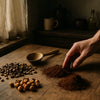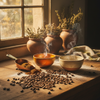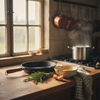Best Kitchen Tool For Zesting Citrus: DI OROs Guide
Key Takeaways
- The best kitchen tool for zesting citrus can elevate your cooking with a simple swipe.
- Using the right zester unlocks the flavorful oils in citrus fruits that enhance dishes.
- Not all zesters are created equal, and some may pose hidden health risks.
- Choosing the proper zester is essential for safe and effective culinary results.
Table of Contents
- The Power and Purpose of Citrus Zest, And Why the Right Tool Matters
- Decoding the Tools, What Are Your Zesting Options, and Who Are They For?
- Anatomy of the Best Citrus Zester, Features That Make All the Difference
- Citrus Zester Face-Off: Microplane vs. Channel Knife vs. Box Grater vs. Peeler
- The Professional's Pick, Best Kitchen Tools for Zesting Citrus (Top Picks, 2025)
- Beyond Lemons, Creative Uses for Citrus Zest and Your Zester
- Caring for Your Zester, Cleaning, Storage, and Safety for Long Life
- DI ORO's Health-First Innovation, Why Material Matters Most
- The Final Zest, Empowering Home Chefs with Tools as Bold as Your Recipes
Best Kitchen Tool For Zesting Citrus: DI ORO's Guide
The best kitchen tool for zesting citrus transforms your cooking from good to extraordinary with one simple swipe. Whether you're adding bright lemon zest to risotto or lime to margaritas, the right zester unlocks those precious oils that make dishes sing. But here's what most home chefs don't realize: not all zesters are created equal, and some harbor hidden health risks that could compromise your culinary creations.
If you're looking to upgrade your kitchen essentials, explore bundles & sets that include the best kitchen tool for zesting citrus and other must-have utensils for home chefs.
At DI ORO, we've tested countless zesters alongside America's Test Kitchen and know what separates professional-grade tools from kitchen drawer disappointments. The secret lies in pro-grade materials, forever-chemical-free construction, and blade precision that captures pure zest without bitter pith.
The Power and Purpose of Citrus Zest, And Why the Right Tool Matters
Citrus zest contains concentrated essential oils that pack 10 times more flavor than juice alone. Unlike the bitter white pith beneath, zest delivers pure aromatic compounds, limonene in lemons, linalool in limes, that professional chefs use to elevate everything from pasta to pastries. The difference between amateur and professional results often comes down to this single technique.
The best kitchen tool for zesting citrus must accomplish three critical tasks: extract only the colored outer layer, avoid dragging bitter pith, and release maximum oils without waste. Cheap plastic zesters fail on all counts, often dulling after weeks and potentially leaching chemicals into your food. Quality tools feature razor-sharp, photo-etched stainless steel blades that glide effortlessly across citrus skin.
Professional kitchens rely on zesters that deliver consistent results under pressure. For home chefs who dream big, this means choosing tools with ergonomic handles, seamless construction that prevents bacteria buildup, and materials certified safe for food contact. When your lemon zest can make or break that dinner party dessert, settling for subpar tools isn't an option.
Decoding the Tools, What Are Your Zesting Options, and Who Are They For?

Five main tool categories dominate the zesting landscape, each with distinct advantages for different cooking styles. Microplane-style rasp graters lead the pack with fine, ribbon-like zest perfect for baking and cocktails. Channel knives create decorative strips ideal for garnishes, while traditional box graters work for large-volume zesting but lack precision.
For a deeper dive into the differences between a citrus peeler and a zester, check out this helpful guide on citrus peeler options and their best uses.
| Tool Type | Zest Texture | Best Use | Skill Level | Cleanup |
|---|---|---|---|---|
| Microplane Rasp | Fine, fluffy | Baking, cocktails | Beginner-friendly | Easy |
| Channel Knife | Long strips | Garnishes | Intermediate | Simple |
| Box Grater | Coarse pieces | Large quantities | Beginner | Moderate |
| Citrus Peeler | Thick strips | Candying, twists | Advanced | Easy |
Professional-grade microplane zesters dominate test kitchens because they combine versatility with precision. DI ORO's approach focuses on seamless, forever-chemical-free construction that eliminates the health concerns plaguing cheaper alternatives. When America's Test Kitchen evaluates zesters, they prioritize blade sharpness, handle comfort, and material safety, exactly where premium tools shine.
Anatomy of the Best Citrus Zester, Features That Make All the Difference
Blade construction separates exceptional zesters from mediocre ones. Photo-etched stainless steel creates microscopic cutting edges that stay sharp through hundreds of uses, while stamped blades dull quickly and tear citrus skin. Optimal blade length ranges from 4-6 inches, providing enough surface area for efficient zesting without becoming unwieldy in compact kitchens.
Handle design directly impacts control and safety. Ergonomic grips reduce hand fatigue during extended use, while seamless construction prevents bacteria accumulation in crevices. Weight distribution matters too, blade-heavy tools require more pressure and increase accident risk, especially when working with small limes or irregularly shaped citrus.
DI ORO's Safety Standard: Our pro-grade zesters feature BPA-free, LFGB-certified materials with zero forever chemicals. Food Network's recognition proves what we've always known: what touches your food matters.
Citrus Zester Face-Off: Microplane vs. Channel Knife vs. Box Grater vs. Peeler
Not all zesters deliver the same results. Here's how the main contenders stack up when evaluating the best kitchen tool for zesting citrus:
| Tool Type | Zest Quality | Ease of Use | Versatility | Safety Features | Best For |
|---|---|---|---|---|---|
| Microplane Zester | Fine, fluffy zest with minimal pith | Intuitive motion, ergonomic grip | Cheese, garlic, ginger, chocolate | Blade guards, non-slip handles | Professional results, frequent use |
| Channel Knife | Decorative strips, not fine zest | Requires technique practice | Limited to citrus garnishing | Sharp blade exposure | Cocktail garnishes, presentation |
| Box Grater | Inconsistent, often includes pith | Bulky, requires counter space | Multiple grating sizes | Knuckle scraping risk | Occasional use, multiple tasks |
| Vegetable Peeler | Thick strips, hard to avoid pith | Familiar motion | Primary peeling function | Standard safety features | Quick zest strips for cooking |
Microplane-style zesters dominate this comparison because they're purpose-built for citrus work. The photo-etched blade creates consistently fine zest without dragging bitter pith along. Box graters, while versatile, produce uneven results and require more effort to avoid the white layer beneath the skin.
Channel knives excel at creating elegant citrus twists for cocktails but fall short for cooking applications where you need finely distributed zest. Vegetable peelers work in a pinch but create thick strips that need additional chopping.
For more on how a lemon grater and zester can bring fresh citrus flavor to your recipes, read this article on lemon grater and zester for fresh citrus.
The Professional's Pick, Best Kitchen Tools for Zesting Citrus (Top Picks, 2025)

Based on testing from America's Test Kitchen and Food Network, plus real kitchen performance, these zesters represent the cream of the crop:
DI ORO Pro-Grade Microplane Zester - Best Overall
Best for: Health-conscious home chefs who demand professional results
Our forever-chemical-free construction sets this apart from standard options. The seamless design prevents bacteria buildup while delivering the fine, fluffy zest that transforms dishes. LFGB certification and BPA-free materials mean you're not adding unwanted chemicals to your carefully crafted meals.
For those who want a complete upgrade, consider exploring kitchen tool bundles and sets that feature DI ORO's pro-grade zester alongside other essential utensils.
Classic Microplane Premium Zester - Most Popular
Best for: Traditional approach with proven performance
The original that started the microplane revolution in home kitchens. Sharp, durable blade produces excellent zest quality, though material safety standards vary by model.
Highlights:
- Razor-sharp photo-etched blade
- Comfortable grip design
- Dishwasher safe options
Considerations:
- No forever-chemical guarantee
- Handle materials vary by price point
OXO Good Grips Zester - Best Ergonomics
Best for: Users with grip concerns or arthritis
The oversized handle reduces hand fatigue during extended use. Non-slip grip performs well even with wet hands, making it accessible for users with dexterity challenges.
Highlights:
- Large, comfortable handle
- Non-slip surface
- Blade cover included
Considerations:
- Bulkier storage footprint
- Plastic components may retain odors
Beyond Lemons, Creative Uses for Citrus Zest and Your Zester
Once you've mastered the best kitchen tool for zesting citrus, expand your culinary horizons with these creative applications:
Everyday Flavor Boosters: Add lemon zest to pasta water for subtle brightness, or fold lime zest into butter for an instant compound spread. Orange zest transforms chocolate desserts, while grapefruit zest cuts through rich, creamy sauces.
For those looking to streamline their kitchen setup, you might also appreciate the ultimate spatula set for kitchen pros to complement your zesting tools.
Caring for Your Zester, Cleaning, Storage, and Safety for Long Life
The right maintenance transforms your zester from a one-season wonder into a decade-long kitchen companion. Clean within minutes of use, citrus oils turn sticky when they dry, making removal exponentially harder.
Run your zester under hot water immediately after zesting, using the back of a soft brush to sweep away stuck zest. For stubborn residue, a quick soak in warm, soapy water loosens everything without damaging the blade. Pro-grade stainless steel zesters like DI ORO's handle dishwasher cleaning, but hand washing preserves blade sharpness longer.
Storage matters as much as cleaning. Blade guards prevent nicks that dull cutting edges, while magnetic strips keep zesters accessible without drawer damage. Wall hooks work for frequent users, but ensure the blade doesn't contact other tools.
5 Commandments of Zester Care
- Clean immediately after use, citrus oils harden fast
- Use soft brushes only; avoid steel wool or abrasive sponges
- Store with blade protection to prevent dulling
- Replace when zest requires excessive pressure or tears instead of cutting
- Choose forever-chemical-free materials that won't degrade over time
Quality zesters show wear differently than cheap alternatives. Pro-grade tools maintain sharpness for years with proper care, while budget options often dull within months. When your zester starts dragging instead of gliding, or requires heavy pressure for fine zest, it's replacement time.
DI ORO's Health-First Innovation, Why Material Matters Most

Your best kitchen tool for zesting citrus shouldn't compromise your family's health. DI ORO's forever-chemical-free promise eliminates PFAS, BPA, and other harmful compounds that traditional kitchen tools often contain. Pro-grade silicone handles and certified stainless steel blades ensure nothing toxic touches your food.
For a scientific look at the health implications of kitchen tool materials, see this research article on chemical safety in food contact materials.
The difference shows in certifications: LFGB approval from Germany's strict food safety standards, FDA compliance, and rigorous testing that budget brands skip. When America's Test Kitchen and Food Network recognize DI ORO tools, they're validating not just performance but safety standards that protect home chefs.
| Feature | Traditional Plastic Tools | DI ORO Pro-Grade Tools |
|---|---|---|
| Chemical Safety | Often contains BPA, PFAS | Forever-chemical-free guarantee |
| Heat Resistance | Melts at 200-300°F | Stable to 600°F |
| Durability | Degrades with use | Seamless construction, lifetime reliability |
| Cleaning | Porous surfaces trap bacteria | Non-porous, bacteria-resistant |
This health-first approach extends beyond individual tools to your entire cooking philosophy. When you choose materials that won't leach chemicals or harbor bacteria, you're investing in long-term wellness alongside culinary excellence. What touches your food matters, and DI ORO's transparency in sourcing and manufacturing ensures you know exactly what you're getting.
To learn more about the culinary science behind zest, visit the Wikipedia page on zest (ingredient).
The Final Zest, Empowering Home Chefs with Tools as Bold as Your Recipes
Choosing the best kitchen tool for zesting citrus isn't just about upgrading your drawer, it's about unlocking creative potential while protecting your family's health. From microplane precision to forever-chemical-free construction, the right zester transforms ordinary ingredients into extraordinary experiences.
DI ORO's award-winning commitment to safety, performance, and innovation gives home chefs the confidence to tackle any recipe. Whether you're zesting lemons for a weeknight pasta or creating intricate garnishes for holiday entertaining, professional-grade tools deliver professional results.
Cook boldly. Zest confidently. Make every meal a gold-medal moment. Your culinary creativity deserves tools that match your ambition, and your health deserves nothing less than the safest materials available. Choose wisely, zest freely, and let every dish reflect the care you put into both ingredients and equipment.
If you're ready to elevate your kitchen, explore premium kitchen tool sets that include the best kitchen tool for zesting citrus and more.
Frequently Asked Questions
What makes a Microplane zester superior to other zesting tools like channel knives or box graters?
A Microplane zester offers finely grated zest with minimal pith, delivering pure, aromatic citrus oils without bitterness. Its sharp, precise blades outperform channel knives and box graters by providing consistent results and greater control, making it the preferred choice for professional-quality zesting.
Why is it important to choose a zesting tool made from pro-grade, chemical-free materials?
Choosing a zesting tool made from pro-grade, chemical-free materials ensures durability, safety, and food purity. Unlike cheap plastic tools that can dull quickly or leach harmful substances, high-quality materials protect your health and maintain peak performance for flavorful, worry-free cooking.
How does the right citrus zester enhance the flavor and aroma of dishes compared to using just citrus juice?
The right citrus zester extracts the vibrant outer peel packed with essential oils, which contain concentrated flavor and aroma compounds not found in juice alone. This adds depth and brightness to dishes, elevating them beyond what juice can achieve on its own.
What features should I look for in a citrus zester to ensure safety, precision, and ease of use?
Look for a citrus zester with sharp, durable blades that remove only the colored zest without the bitter pith, a comfortable, non-slip handle for control, and materials that are chemical-free and easy to clean. These features combine to deliver safe, precise, and effortless zesting every time.




